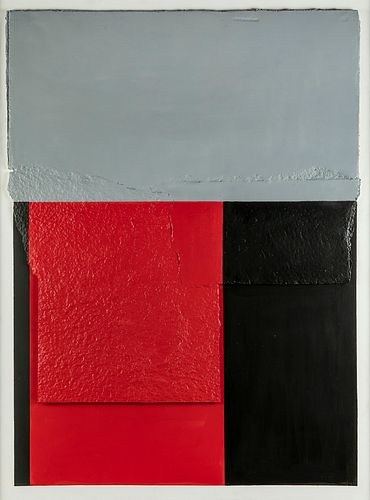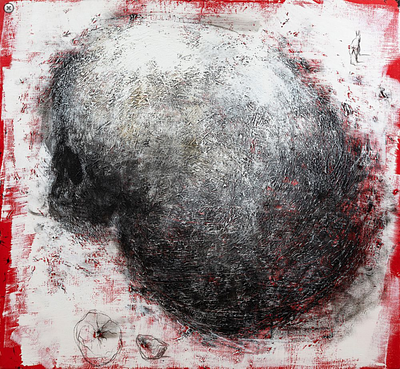RAFAEL CANOGAR GÓMEZ (Toledo, 1935). "Imposta", 2007. Construction on handmade paper and painted in oil glued to board. Signed and dated lower right:
Lot 84
About Seller
Setdart Auction House
Carrer Aragó 346
Barcelona
Spain
Setdart Subastas was born in 2004 and is currently the first online art auction in Spain with solidity, prestige and reliability guaranteed by our more than 60,000 users. Setdart has a young, dynamic and enterprising team ready to successfully manage the purchase and sale of art works through custom...Read more
Estimate:
EUR€23,000 - EUR€25,000
$23,958.33 - $26,041.67
Absentee vs Live bid
Two ways to bid:
- Leave a max absentee bid and the platform will bid on your behalf up to your maximum bid during the live auction.
- Bid live during the auction and your bids will be submitted real-time to the auctioneer.
Bid Increments
| Price | Bid Increment |
|---|---|
| EUR€0 | EUR€10 |
| EUR€200 | EUR€25 |
| EUR€500 | EUR€50 |
| EUR€1,000 | EUR€100 |
| EUR€3,000 | EUR€200 |
| EUR€5,000 | EUR€500 |
| EUR€10,000 | EUR€1,000 |
| EUR€20,000 | EUR€2,000 |
| EUR€50,000 | EUR€5,000 |
About Auction
By Setdart Auction House
Oct 19, 2021
Set Reminder
2021-10-19 08:00:00
2021-10-19 08:00:00
America/New_York
Bidsquare
Bidsquare : CONTEMPORARY ART
https://www.bidsquare.com/auctions/setdart-auction-house/contemporary-art-7701
Setdart Auction House sofia@setdart.com
Setdart Auction House sofia@setdart.com
- Lot Description
RAFAEL CANOGAR GÓMEZ (Toledo, 1935). "Imposta", 2007. Construction on handmade paper and painted in oil glued to board. Signed and dated lower right: "Canogar 07"; inscribed lower left: 'IMPOSTA'; date, signature and inscription on the back: "07 / Canogar / 'IMPOSTA'". Work catalogued on the artist's website. Exhibitions: - 2007. Rafael Canogar. Fragmentations. Oporto (Portugal), Galeria Sala Maior, 21 April-30 May. - 2009. Rafael Canogar Accademico di Spagna. Florence (Italy), Archivio di Stato di Firenze, 13 May-24 June. - 2010. Rafael Canogar. 75 Years/75 Works. Porto (Portugal) Centro de Congresos da Alfândega, 13-28 November. Bibliography: - BARBERO, Giovanna and DORFLES, Gillo: Rafael Canogar Accademico di Spagna. Roma, Verso l'Arte Edizioni, 2009 (Repr. colour p. 52, mixed media). - PAREDES, Tómas, BARBERO, Giovanna and GARCIA BERRIO, Antonio: Rafael Canogar. 75 años/obras. Museo de la Alfándega, Oporto (Portugal), 2010 (Repr. colour p. 163 and 258 with mixed technique). - VIVAS, Lola: Rafael Canogar. Fragmentações. Oporto, Galeria Sala Maior, 2007 (Repr. colour s/p., mixed media). Presents label of the Cordeiros Gallery. Sizes: 151 x 113 cm; 172 x 120 cm (frame). Based on an image where abstraction becomes aware of the compositional space, Canogar confronts grey, red and black, three recurrent tonalities in his production, which reveal an open debate towards socio-cultural concepts. This use of flat, aesthetically opposed colours, which draw from different primary colours, responds to the desire for opposition and contradiction that prevails in many of the artist's works. In fact, Canogar states: "My work wishes to reflect, in its form of birth, in its genesis, those two elementary and primary forces that have always accompanied man: constructive and destructive forces, or construction-deconstruction. Opposing forces and the struggle of opposites, as a structural part of my work; as the reality of man who lives immersed in his own contradictions". Co-founder of the group "El Paso" in 1957, during the 1950s he developed a fully informalist work, which in the 1960s developed into an increasingly complex narrative figuration. From the 1960s onwards he achieved international recognition as a visiting professor at Milles College in California to teach the art course 1965-66, and as a guest artist at the Tamarind Lithography Workshop in Los Angeles in 1969. Between 1972 and 1974 he was also invited by the D.A.A.D. in Berlin as an artist in residence. During his mature period, from 1975 onwards, Canogar invented a new iconography, his own and personal, which he expressed through the mask, the head, the face, as a representation of man who loses his individuality and becomes a plastic sign. His work was also recognised in Spain, and during the 1980s he was a member of the Advisory Council of the General Directorate of Fine Arts of the Ministry of Culture, of the Board of Trustees of the National Museum of Contemporary Art in Madrid, and a member of the Board of Directors of the National Heritage. Throughout his career, Canogar has held countless solo and group exhibitions. Among the personal exhibitions, several have been retrospectives, including: Museo Nacional de Arte Contemporáneo and Biblioteca Nacional de Madrid, Musée d'Art Moderne de la Villa de Paris, Sonia Heine Foundation in Oslo, Konsthalle de Lund in Sweden, Paris Art Center, Bochum Art Museum in Germany, Istituto di Storia dell'Arte de Parma, Museo de Bellas Artes de Bilbao, Fundación Casa del Cordón de Burgos, Museo de Santa Cruz de Toledo, Museo Reina Sofía in Madrid, etc.
- Shipping Info
-
In-house shipping available. Please inquire at admin@setdart.com.
-
- Buyer's Premium



 EUR
EUR CAD
CAD AUD
AUD GBP
GBP MXN
MXN HKD
HKD CNY
CNY MYR
MYR SEK
SEK SGD
SGD CHF
CHF THB
THB















